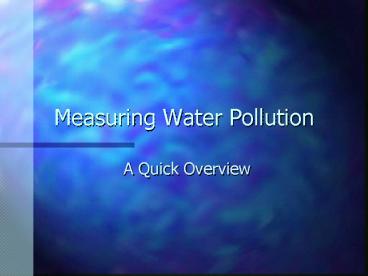Measuring Water Pollution - PowerPoint PPT Presentation
1 / 21
Title:
Measuring Water Pollution
Description:
Solids content (TSS, Conductivity, Secchi disk, settleable solids) ... Degraded benthos. Eutrophication or undesirable algae. Loss of fish or wildlife habitat ... – PowerPoint PPT presentation
Number of Views:216
Avg rating:3.0/5.0
Title: Measuring Water Pollution
1
Measuring Water Pollution
- A Quick Overview
2
How do you measure the quality of a moving, ever
changing fluid medium?
3
Two Basic Approaches
- TECHNOLOGY-BASED LIMITS Use a certain treatment
technology (BPT, BAT, MACT, BPJ) to achieve a
given quality of effluent (work backward from
effluent chemistry)
- WATER QUALITY-BASED LIMITS Quantitative
relationship between inputs and quality (LD50,
NOEL)--dose/response risk assessment, hydrology,
mass balance
4
The Conventional Pollutant Measures
- Oxygen (BOD, COD, DO)
- Solids content (TSS, Conductivity, Secchi disk,
settleable solids) - Nutrients (phosphorus, nitrogen)
/Algae/Eutrophication - Acidity (pH)
- Bacteria (e.g., fecal coliform)
- Temperature
5
Oxidizing (Oxygen-Using)Reactions
- Fire
- Metabolism of humans and animals
- Fate of pollutants in water
- C in fuel combines with atmospheric O2
- carbon-bearing organic compounds oxidized to
CO2,water, energy - pollutants are oxidized, depleting O2 in water
6
Assimilative capacity ability of a waterbody
to convert a pollutant into something harmless
(to whom or what?)
7
Measures of oxygen in water
- Dissolved oxygen (DO)--time and space variables,
dilution - Biological oxygen demand, five days (BOD5)
- Chemical oxygen demand (COD)
- Sediment oxygen demand (SOD)
8
Oxygen and other pollutants may vary according to
- Fluctuations in inputs (lagged)
- Time of day (day-night)
- Time of year (summer-winter)
- Water temperature (thermal stratification)
- Stream flow
- Which in turn varies with land clearing/impervious
cover, storm events, seasonal variations,
channel structure, etc.
9
Sediments
10
Effects of sediment loading
- Destruction of spawning beds
- Adsorption and transport of other pollutants
- Reduced light penetration, aquatic vegetation
- Greater nutrients loadings, oxygen demand
- Interference with navigation, flood control,
recreation, industry
11
Effects of nutrient loadings (N, P measured by
Chlorophyll a, Secchi, algal species)
- Algae blooms
- DO changes, fish kills
- Shift of trophic status toward eutrophic
- Drinking water impairment (direct and indirect)
- Aesthetics (color, clarity, smell)
- Uptake and release of toxics
12
Effects of acidification(measured in pH--log
scale)
- Direct kill of living things
- Shift toward acid-tolerant species
- Mobilization (dilution, desorption) of metals and
other toxics
13
Toxics and Bioaccumulation
14
Impacts of toxics
- Acute mortality (instant death)
- Chronic illnesses (e.g., cancer)
- Toxicity at low doses (e.g., dioxin)
- Reproductive and developmental toxicity (hormone
mimics) - Persistence over space (toxaphene) and time
(PCBs) or transformation (DDT to DDE, PCB
dechlorination, methyl mercury) - Storage in reservoirs (sediment sinks)
15
Some approaches to toxics parameters
- Chemical levels (water, sediment)
- Ability to support designated uses
- Ability to support beneficial uses
- Fish advisories
- Historical baselines
- Background levels
- Narrative criteria (no toxics in toxic amounts)
16
Traditional sampling grab samples
17
Automated MeasurementsSondes (Hydrolab or YSI)
- Automated sampling of basic conventional
parameters - Fine-grained (e.g., every 15 minutes)
- Download to laptop for analysis
18
Indices
- Bring diverse measurements together into a
single-number value
19
Ecosystem approaches
- Look at interactions of living and nonliving
parts of the ecosystem (whats an ecosystem?) - Try to identify stresses and responses
- Holistically integrate physical, biological, and
social aspects of the area in question
20
Institutional Context Remedial Action Plan
- Great Lakes Water Quality Agreements
- Areas of Concern
- Plan to restore beneficial uses
21
Beneficial Uses
- Restrictions on Fish Consumption
- Restrictions on Dredging
- Added costs to agriculture or industry
- Tainting of fish flavor
- Restrictions on drinking water consumption
- Degraded fish or wildlife populations
- Degraded benthos
- Eutrophication or undesirable algae
- Loss of fish or wildlife habitat
- Fish tumors or deformities

